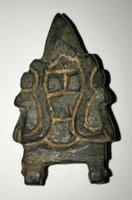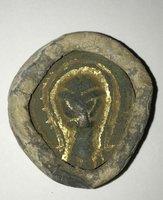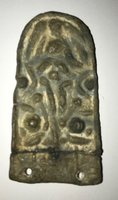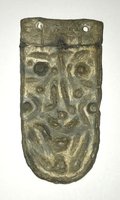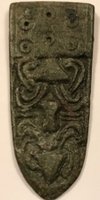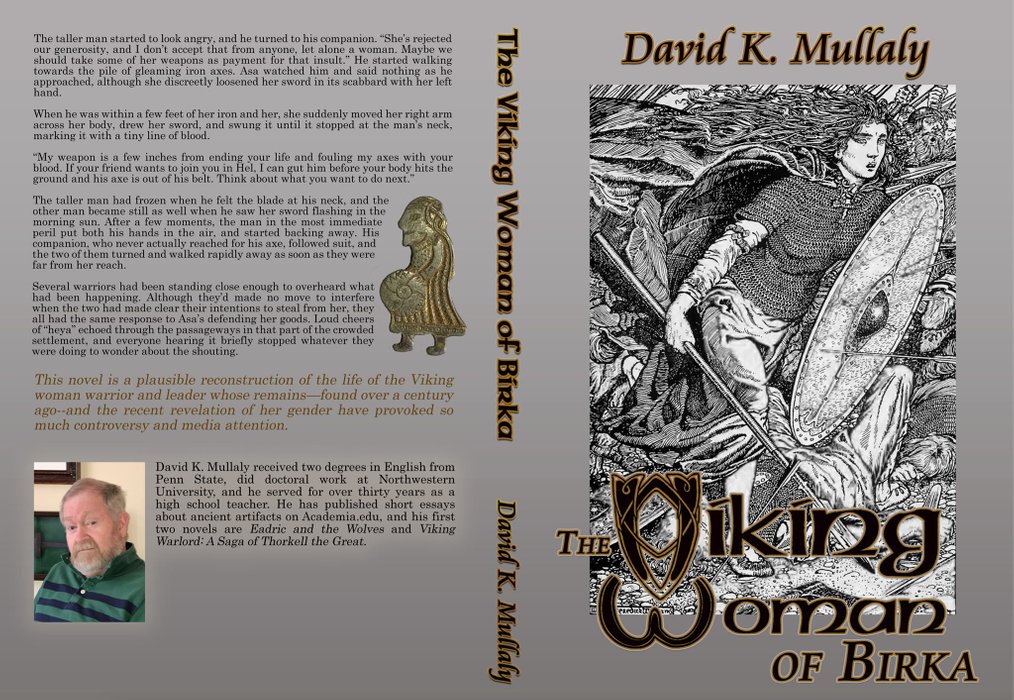In this blog, I like to give way to an article, written by David Mullaly, author of novels about the Viking Age addicted lover of artefacts from the Viking Age, but, above all, a by me truly valued estimated specialist when it comes to knowledge of Viking Age artefacts. My ally overseas and soul mate.
Hereunder he discusses the representation of the Norse god Thor on artefacts from the Viking Age.
The Elusive Face of the Viking God Thor
The two most popular gods in the Norse pantheon were Odin and Thor, and it’s reasonable to expect that the Norse people would want to represent them in decorations on their jewelry and other items. Some artifacts decorated with images of human-like figures, the identities of some of which are unclear, provide a few clear markers for Odin.
If the face has only one eye, and the other eye is unquestionably absent, then the object was presumably intended to provide an image of Odin, the Allfather. He was willing to give up one eye in exchange for wisdom. If the human-like image includes the figures of two birds, Odin again is indicated. He was provided with two ravens, Hugin and Munin, who traveled the world to get information about whatever interested Odin. As I suggested in another commentary, The Odin Mount Revisited – The Converting Element, this supernatural being may also have been represented wearing some sort of interlaced crown or head piece.
Other artifacts featuring a realistic face of a Norse male with large round eyes have been identified as a representation of Odin, although one should take that attribution with at least a few grains of salt.
Finding images intended to represent Thor is more complicated. Of course, Thor has his hammer, called Mjölnir, as a symbol. Many examples of hammer pendants have been found over the years—in gold, silver, bronze, bone, lead. In fact, some were probably made of wood, although long-term survival was always unlikely. However, exchanges with experienced metal detectorists, and by extension with UK Finds Liaison Officers, suggest that some artifacts found with more abstract faces were intended to represent Thor. These are in some cases clearly representative of the “hidden faces” inclinations of Norse craftsmen as I have written about in The hidden face motif in Viking Age artefacts.
Example A is a bronze buckle plate with some surviving gilding, found at Pocklington, near York. A pair of flanking vertical beasts lead one to a crude face in the center surmounted by what might be seen as a pointed helmet, and the beasts become long hair next to the face. This was identified by a FLO as a face of Thor.
Example B is a lead weight or game piece with a gilded bronze insert showing an alien-looking face with an elongated neck and slanted eyes, found near York. Again, a FLO identified this as a representation of Thor. The shape of the head and long neck is similar to faces found on various Norse-Finnic tortoise brooches and other artifacts, but the eyes are very different.
Example C is a more complex artifact. Found near Malton in the Yorkshire Wolds, it is a complete large lead strap end with a minor period repair on the back of the fastening plate. When the item is examined with the flat area at the bottom, one can see at the top a raised area which provides the shape of a winged beast, and on the outsides snake-like animals with gaping mouths about to swallow something round. When the flat fastening area is at the top—which is how the piece would normally be viewed–a clear stylized face with prominent round eyes, a nose, and a smiling mouth is visible.
Example D is a very large (63mm long) bronze strap end found near Blackpool, north of Liverpool. While the decoration is fundamentally a Borre knot chain with deep contours, there is a clear stylized face featuring a frowning expression with a prominent nose created by joined knot triangles. Below that appears to be a grimacing mouth. A typical Borre knot chain involves a deliberate symmetry, involving loops of an equal size (see the darker example), whereas this one is much larger at the top, emphasizing the asymmetrical face element. The difference is subtle, but quite visible.
In each example, the face of the being displayed is mysterious: the features are either just hinted at by a shortage of details, or obscured by stylized features which distance us from a human-like representation. Whether the Norse believers in Odin and Thor saw one as more human-like and relatable, and the other as enigmatic and less so is open to question, but that difference wouldn’t surprise me.
Note: after publishing Eadric And The Wolves: A Novel of the Danish Conquest of England and Viking Warlord: A Saga of Thorkell the Great in not too far future David Mullaly will publish his third novel: The Viking Woman of Birka.
See for latest news on David Mullaly on his Facebook page.
See for other articles written by him about Viking Age artefacts on:
Well. I could have been with these stones until after dark, but as my wife wanted to travel on.. well.. I see you again, some day, hogback stones from Gosforth. And if you happen to be there one day, do not forget that monument on the outside...
Further on with the Cumbrian hogbacktour !
In - yes, luckily again in - St. Peter's church in Heysham, there is a truly beautiful hogback stone. The guide told us, it had been studyied by Thor Ewing, a writer, in 2000. in 'Understanding the Heysham hogback' A tenth century sculpted stone monument and its context (link), Thor Ewing tells in detail what he dicovered on the both sides of this hogback stone.
Just being brought in the church as late as the 1970's accompanied with some protest here and there among the church visitors, considered as being a token of old paganism, it had been remarkably nice preserved, and a lot of detail can be seen, still. Truly worthwile a visit.
I had a small debate with the guide in the church if the - zoomorphic, in my opinion - faces on the sides were lions (or hippo's). The guide doubted if the vikings could have known about lions. Well I guess so, concerning the runes on the Ancient Greek lion statue at the Arsenal, Venice. For example. Vikings did travel south..
But when he told me he was doubting the vikings 'discovered' (as the native inhabitants were of course, in the first place) America before Columbus, I decided to rest my case..
One has to know when to start and to end a conversation ..
Just discovered the book in a bookstore written by Geoff Holder - The guide to the mysterious Lake District, I knew there had to be another hogback stone in Lowther, St. Micheal's Church. With a promising image described in the text of 'a naval and a land-based force of shield-bearing vikings above a fish and what might be a coiled sea serpent. On the reverse is a row of female figures with snakes, possibly a representation of the hideous hag Hel'. Wow. If that did not sound as a true pagan promised land ..
Not complaing too much after all we have seen, this visit was the dissapointing one of them all. But if you wife states 'I am happy to have seen them' and I am answering 'Measuring is knowing' and the even more obligate verb 'handling 'if we did not see it at all, we wouldn't have known anything at all of how they were looking' the glass was again half full, at the last day of our journey..
The hogback stone appeared to be just being tolerated within the entrance segment part of the church. As something you never use anymore but you do not throw away - entirely. That sort of feeling emerged when seeing this hogback asylum seekers.. Bed, bath and bread, ás we say in Dutch, but no luxury at all and standing on some outcuts of wood, you would balance the table with at home..
Come on, St. Micheal's Church.. care a bit more of your 'children' !
This hogback stone was moved in the church in 1907. Hogback stones layed partially buried in the churchyard before it was dug up and moved into the church.
The promising depiction of a longship - as certainly can be seen after some studying - see http://vikingminds.co.uk/pages/longship
we have missed !
The stone itself is (157 x 50 x 30 cm) and very worn.
The hogback stones in Cumbria - very diverse in quality, but everyone worth a visit ! Especially on a gloomy day in late October ...
The churches to visit - see photos of resp. St. Andrew's church in Penrith, St. Mary's church in Gosforth, St. Peter's church in Heysham and St. Micheal's church in Lowther.
Did I miss out on another one in Cumbria ? Let me know !
In a next blog I will take you to four - still remaining utterly mysterious- statues 'guarding' the graveyard of St. Andrew's church in Dacre..
For the last blog of October 9th see this link.
References: (as always, links to where the books can be ordered are attached).
Edwards, B.J.N. Vikings in North West England - The artifacts (1998);
Emery, Gordon, CURIOUS CUMBRIA, The Lake District & Beyond: A celebration of Cumbria (2023)
Ewing, T. 'Understanding the Heysham hogback' A tenth century sculpted stone monument and its context ;
Hall, R. Viking Age archaeology in Britain and Ireland (first printed 1990, reprinted with amendments in 1995);
Holder, G. The guide to the mysterious Lake District (2009)
possibly also (as there within the part of Cumbria dealing with Carlisle, the Eden Valley, Barrow-in-Furness, Whitehaven and the west coast is being dealed with)
Holder, G. Paranormal Cumbria (2010)
http://vikingminds.co.uk/pages/longship

